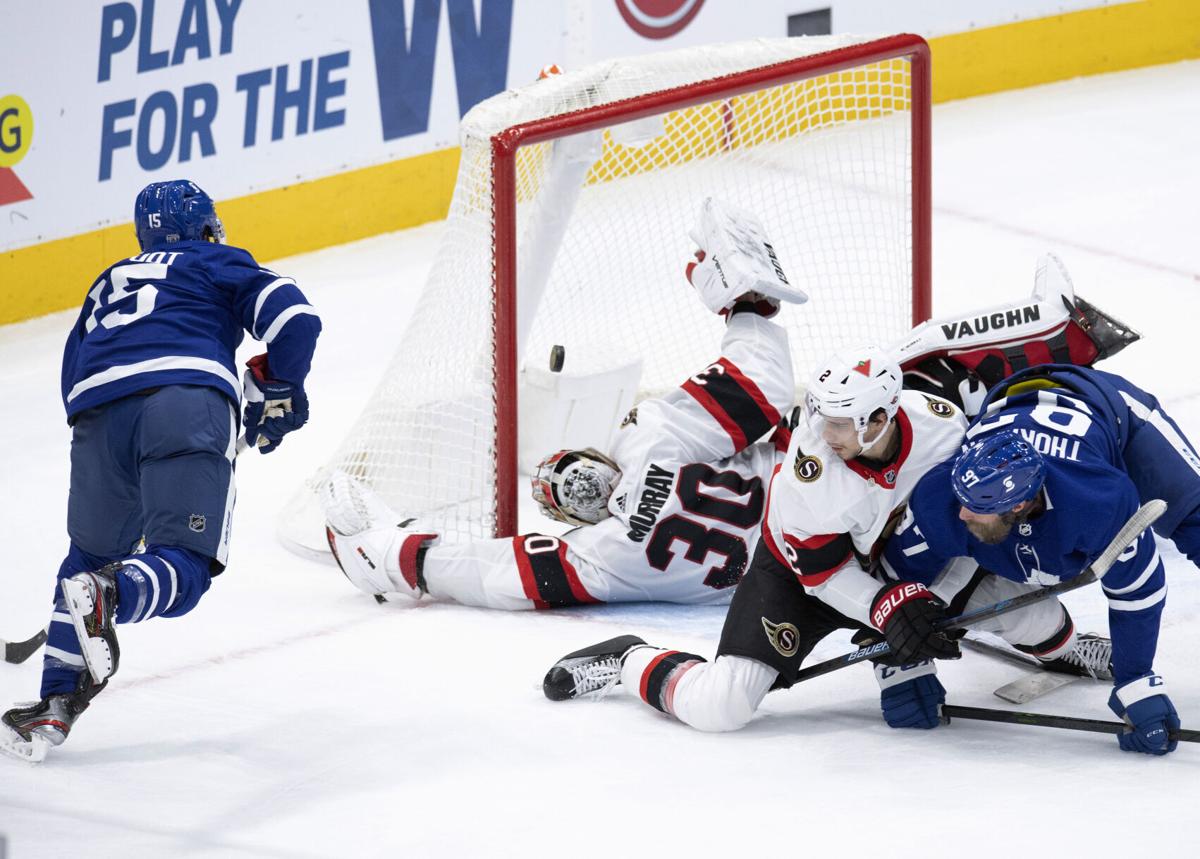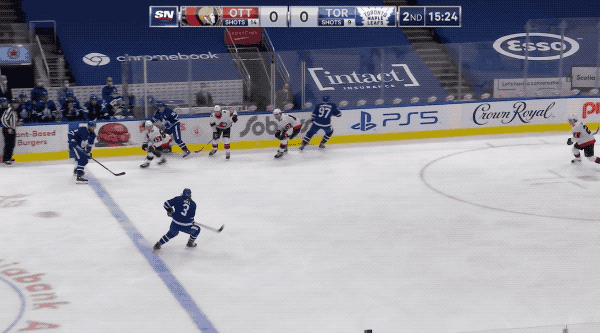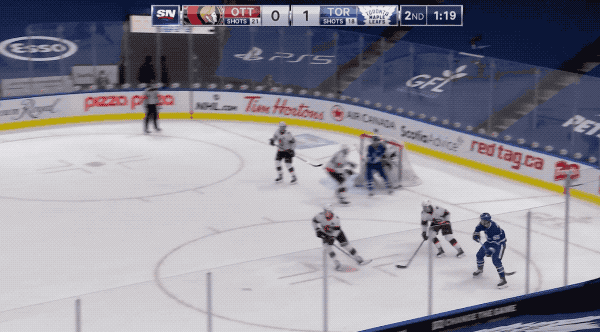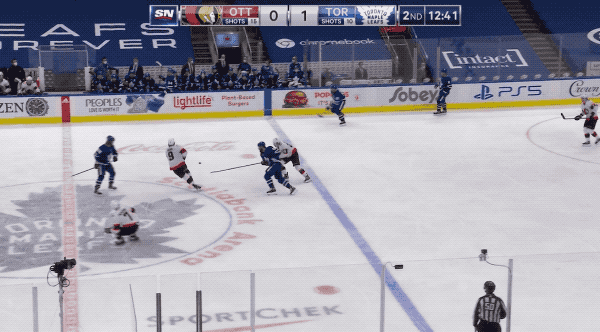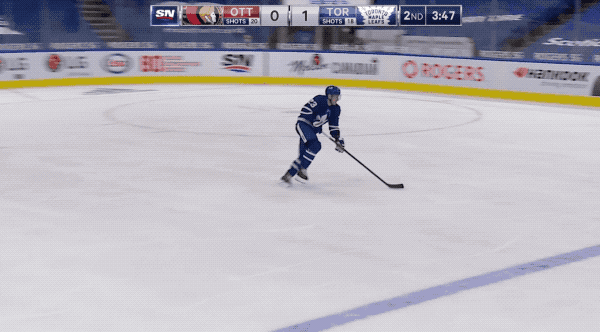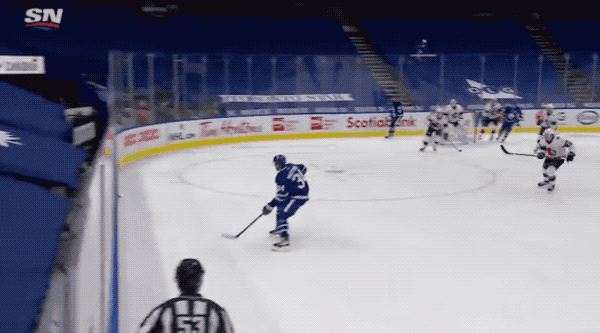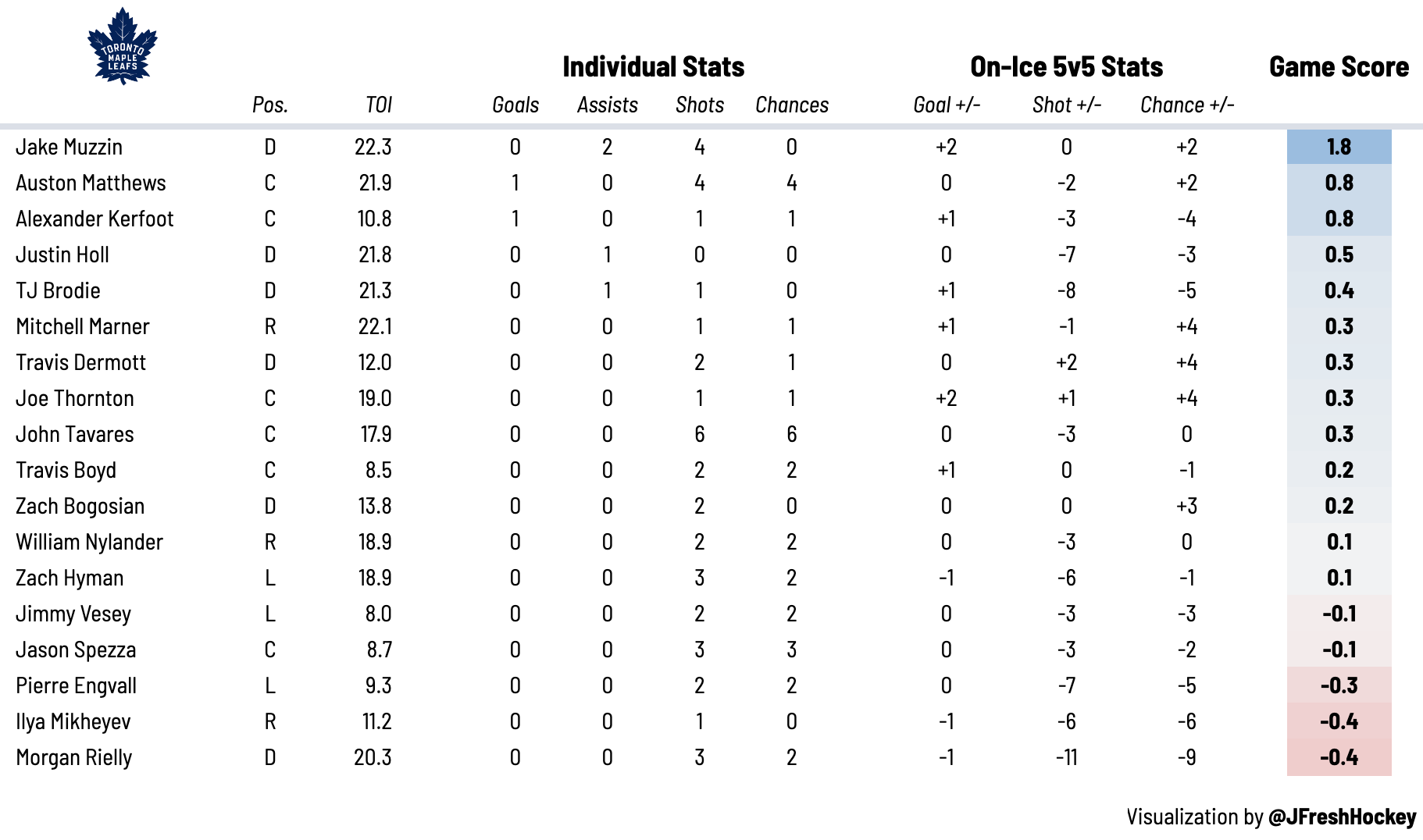Trap game – literally.
After coming out of the gates at a snail’s pace, Toronto started to turn things around in the second period and really kicked things into gear by the third period. That’s obviously not the way they drew things up, especially following their 5-1 collapse on Monday night, but the Leafs were able to come out of this game with two points, defeating the Senators by a final score of 2-1.
Ottawa’s 1-3-1 neutral zone trap, not as much of a factor in Monday’s game that was full of goals and momentum swings, seemed to throw Toronto off guard early in the game as the Senators executed well within their structure. Then again, that’s something they’ll need to learn how to get past. Coaches have been trying to trap up high-skill teams for decades. It’s nothing new.
The Leafs found a way eventually, although it definitely wasn’t their strongest performance of the year. To break things down in a bit more detail, let’s assess each player’s individual performance by diving into the report cards!
5/5 Stars
Game Puck: The Leafs‘ actual 1st Pairing — By this, of course I mean Jake Muzzin and Justin Holl. They’ve consistently tilted the ice in their team’s favour better than the Rielly-Brodie pairing despite facing similar competition.
That’s in large part because of both players’ gap control in transition; Muzzin and Holl don’t give opposing forwards any room when they’re trying to slice through the neutral zone. That’s why Muzzin-Holl were on the ice to defend Tim Stuzle & company in the dying minutes – they don’t allow many rush chances against.
Let’s not forget that both defensemen were able to produce offense tonight by consciously looking to set up their team’s best scorer:
It turns out passing the puck to Auston Matthews is still a good idea.
Joe Thornton (LW, #97) — The way he occupies space at the bottom of the offensive zone is really interesting to watch. Thornton reminds me of a low-post player in the NBA with the way he uses his size and long reach to keep opposing players on his back (or butt) while he surveys the defense and looks for the next pass.
By giving his teammates an easy passing option behind the net, Toronto was able to live in the offensive zone when Thornton was on the ice, constantly cycling the puck down low to him behind the goal-line. At one point, that line had Ottawa hemmed in their own end for over two minutes, eventually resulting in a drawn penalty by Thornton.
He was also able to sneak his way out front for what appeared to be a goal.
Joe Thornton is slow. But here he is strategically slow.
Look for the same play from Crosby too. pic.twitter.com/u7WZoz2NgP
— Jack Han (@JhanHky) February 18, 2021
Back when I used to referee youth hockey, I remember being in meetings where it was explained that the play ends when the official “intends” to blow the whistle. Believe me, it’s not fun explaining that one to coaches.
I think that the Thornton goal should count. You should be able push the pad in if you’re pushing the puck in to the pad. Puck wasn’t covered, Player should be entitled to attack puck if it isn’t covered. As long as Thornton is pushing puck in to pad and not pad itself.
— Mike Johnson (@mike_p_johnson) February 18, 2021
Preaching to the choir here, Mike. Fun fact: Thornton had another goal waived off because of a high stick. The hockey gods just weren’t with him tonight, and yet he was the one at the front of the net creating the havoc that led to the game-winning goal by Alex Kerfoot.
Auston Matthews (C, #34) — We’re starting to hold Matthews to such a high standard that it’s becoming difficult to look for ways to him improve. He’s winning almost every puck battle this season and dictating play in transition. As you saw in the Muzzin-Holl section, Matthews was able to score another goal with his patented one-timer, putting him on pace to score a staggering 50 goals in 55 games.
If we are going to nit-pick, though, there was one specific backcheck where Matthews was late to recognize he was the 3rd forward (F3) who was supposed to be covering for Holl.
Matthews has now officially scored on every NHL team.
4/5 Stars
Frederik Andersen (G, #31) — After Monday night’s debacle, it was nice to see Andersen bounce back with one of his stronger performances of the season. The team in front of him did a pretty good job at limiting high-quality shots, but you still need to makes the saves. Andersen did that tonight, at least on 27 of the 28 shots he faced. He needed to be sharp early to help the Leafs settle in and came up big there.
Jason Spezza (RW, #19) — His composure with the puck really stood out to me last season, especially right after the coaching chance. In Keefe’s system, puck possession is highly prioritized, which fits in well with Spezza’s patient approach to buildup play.
By taking a calculated risk in his own end, Spezza gets rewarded with a rush opportunity at the other end.
It’s also worth noting that Spezza took a few shifts with Matthews-Marner tonight, which looked pretty good. It was a creative way to maximize the team’s chances of winning the faceoff on the right side of the ice.
You don’t want Thornton playing as many minutes as Toronto’s big guns, so why not spell in a Spezza or Hyman every now on then?
Alex Kerfoot (C, #15) — He was flying tonight. Kerfoot’s always been a fast skater, but he’s struggled this season to create dangerous opportunities off the rush.
That wasn’t the case on Wednesday night. Kerfoot was transitioning the puck from defense to offense with his legs, but more importantly, connecting on that next pass through the middle of the ice. It’s too bad Pierre Engvall insisted on whiffing on those chances.
As luck would have it, a Muzzin point-shot landed right in front of Kerfoot later in the game, where he was able to bury the eventual game winner.
Played it perfectly 👏#LeafsForever pic.twitter.com/RbBcAt4dz4
— Toronto Maple Leafs (@MapleLeafs) February 18, 2021
Sometimes you need a bit of luck to get you going offensively. Here’s hoping that’s the case with Kerfoot, although his linemate quality doesn’t exactly inspire a lot of confidence.
3/5 Stars
The Tavares-Nylander Line — Better is the way I would describe them tonight. I still think there’s another level Toronto’s second line can hit offensively. Then again, once Tavares’ shooting percentage regresses back up to where it should be, I’m sure we’ll stop hearing so many complaints about the Tavares-Nylander combo.
Hmm I wonder what's changed for John Tavares at 5v5 this season. pic.twitter.com/FsnaA4rjdE
— draglikepull (@draglikepull) February 17, 2021
Something tells me Tavares isn’t going to keep shooting three percent all season.
When it comes to Nylander, part of me doesn’t even want to address some of the criticism that comes his way – I prefer sharing high-quality work in this field. Then again, it has made me realize that there’s always going to be a large portion of this fanbase who doesn’t value Nylander.
Just remember that when we’re assessing his value defensively, he defends the rush better than Rielly.
The Leafs got the puck back on this play, which tends to happen when #88 is on the ice.
Mitch Marner (RW, #16) — I saw quite a bit of disagreement online with respect to Marner’s play tonight. Early on, I thought he was fantastic at picking off passes and creating some kind of dangerous chance off of the turnover. Marner was also great on the backcheck, turning a couple odd-man rushes into even-man rushes, which really helps stack the deck in your goaltender’s favour.
As the game went on, he seemed to be a bit off in his passes. There were times he had Matthews open in a good spot and he’d miss him by a few inches, sometimes even a few feet. For someone who makes a living off of those passes, you’d like to see Marner look a bit sharper in that regard.
Travis Boyd (C, #72) — Despite his 46 percent shot share (CF%) at even strength this season, I’ve liked what I’ve seen from Boyd as a passer.
That said, I’m not sure if playing bumper on the power play is the right role for him. He turned the puck over the one time he touched the puck on an entry attempt. When the 5v4 unit got set up in the offensive zone, Ottawa’s penalty killers essentially ignored Boyd (and Thornton), sending their forwards to pressure Matthews & Marner on the half-wall. It really disrupted them, making me think that unit needs more of a shot threat in the middle of the ice.
I wonder what Nick Robertson would look like in that spot.
2/5 Stars
The Dermott-Bogosian Pairing — I don’t want to spill too much ink evaluating Zach Bogosian tonight, since we all pretty much know what type of defenseman he is at this point. With Travis Dermott, he seems to be playing with a lot more confidence lately.
It’s probably what made him think this was a good idea.
It wasn’t.
I love it when Dermott uses his skating to make dynamic plays in transition, but it’s worth noting his zone entry numbers have never been as strong as his zone exit numbers. This means he’s had a much easier time getting out of his defensive zone with possession than he does getting into the offensive zone with possession.
After crossing center ice, I’d be looking to defer more to my talented forwards if I were Dermott.
TJ Brodie (RD, #78) — We’ll discuss his defense partner in detail at the end. For now, I’d like to quickly bring up Brodie’s play on the power play. I don’t love it. We’ve seen Mikko Lehtonen or even Rasmus Sandin last season quarterback the second unit with much more confidence walking the line.
The Leafs don’t have many other great options to put there (Dermott? Muzzin?), especially when they’re only playing six defensemen, but it’s reaching the point where there’s a noticeable drop-off in quality between the Rielly unit and Brodie unit, at least to my eye test.
The Long Lanky Wingers — We’re going to group Pierre Engvall and Ilya Mikheyev together here, since they both played a similar role on the third line tonight. That role was to apply pressure defensively and provide next to nothing offensively. Engvall had a couple Kerfoot passes hit him on the tape in the slot, but he couldn’t connect on the one-timer right away, which allowed Ottawa’s goaltender to get across in time to make the save.
We’re also going to throw Jimmy Vesey in this section because he had the same kind of night. I’ve actually liked him a lot more defensively than I expected to; he has a knack for getting his stick in the passing lanes. The issue is that he’s still isn’t generating much of anything offensively.
1/5 Stars
Morgan Rielly (LD, #44) — I think a few of us need to take a good look in the mirror and ask ourselves how we’re evaluating defensemen in the year 2021.
Rielly’s speed allows him to jump up into the play and create offensive opportunities for his team, but when you consider how much he gives up the other way, you start to wonder if the risk is worth the reward at times.
This is one isolated play, but it’s representative of a larger problem. Rielly has always allowed more shots and scoring chances against than his peers defensively. The Senators’ best chance to tie it in the final five minutes also came on a play where Rielly took himself out of position inside the defensive zone and a pass went through him.
Maybe we all need to accept Morgan Rielly for what he is: a fourth forward. That can have a lot of value when you desperately need to score a goal. If we’re talking about his 200-foot impact on winning, though, I think it’s fair to say that Leafs fans have overrated Rielly’s impact at 5-on-5 for a while now.
Heat Map
Here’s a quick look at where each team’s shots were coming from at even strength, courtesy of Natural Stat Trick.
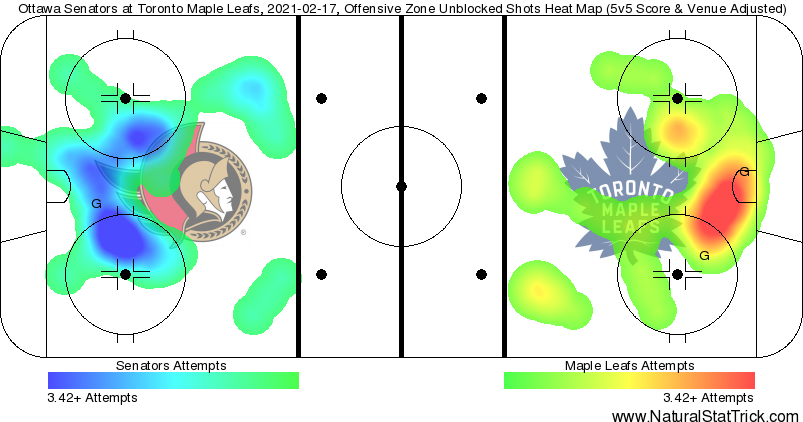 Toronto got pretty badly outshot at even strength, with Ottawa controlling 58 percent of the shots. It is worth noting the expected goals had them at 50-50.
Toronto got pretty badly outshot at even strength, with Ottawa controlling 58 percent of the shots. It is worth noting the expected goals had them at 50-50.
Game Score
Game score is a metric developed by The Athletic’s Dom Luszczyszyn to measure single game performance. You can read more about it here.

























